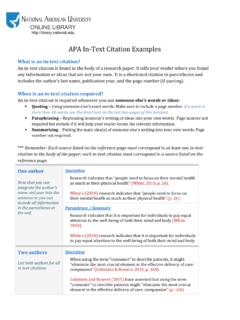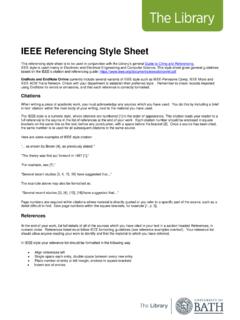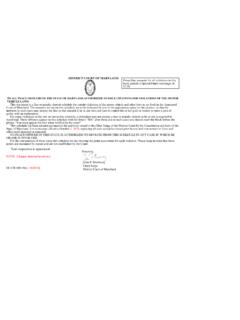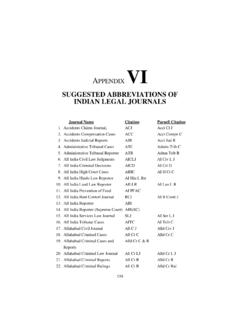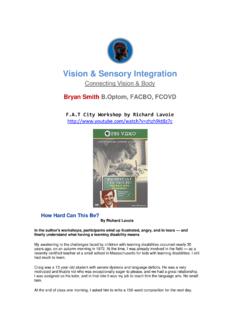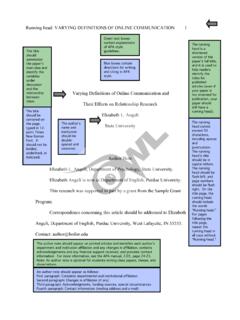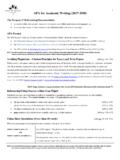Transcription of EU MDR - Suggested Table of Contents for the Clinical ...
1 EU MDR - Suggested Table of Contents for the Clinical Evaluation Report - CER Observation 1 - This is the third installment of my series on medical device Clinical evaluation. I suggest reading the first part at ( ) to have a better understanding of the concepts so the understanding of this part is easier). Introduction The Clinical Evaluation Report - CER is the document which contains the results of the application of the Clinical evaluation requirements and process by the manufacturer, for a medical device. The MDR and also current MEDDEV Rev 4 - Clinical Evaluation contains general information on the Contents of the CER (the MEDDEV also provides a suggestion for a general TOC, however, they are too general and high level.
2 We ve been using a modified TOB based on the activities mentioned in the first post of this series ( ). The suggestion is below. Suggested Table of Contents for the Clinical Evaluation Report - CER Part 1 - Introduction - Introduction - Objective - Reference Documents - Definition of Clinical evaluation team - Expert in research methods and design - Librarian or search expert - Data Management Expert - Activities in the Clinical evaluation stages - Declaration of interests for the Clinical evaluation team - Summary - Scope of the document Part 2 - Scope of the Clinical evaluation Part - Device description - Name, models, sizes, components of the device, including software and accessories - Device group to which the device belongs ( biological artificial aortic valve) Whether the device is being developed/ undergoing initial CE-marking/ is CE-marked Whether the device is currently on the market in Europe or in other countries, since when, number of devices placed on the market - Intended purpose of the device - Exact medical indications (if applicable)
3 - Name of disease or condition/ Clinical form, stage, severity/ symptoms or aspects to be treated, managed or diagnosed - The intended patient population, subdivided into groups if applicable, with clear indications and contraindications for each population or group - Detailed description of intended Clinical benefits to patients with relevant and specified Clinical outcome parameters, subdivided into groups if applicable - Detailed description of the intended performance, including the technical performance of the device intended claims regarding Clinical performance and Clinical safety that the manufacturer intends to use - Intended users (use by health care professional / lay person) - For each group of intended users 1 - Occupational description - Demographic characteristics - Physical characteristics - Skills - Potential impairments - Performance shaping factors - Learning style - Organs / parts of the body / tissues or body fluids contacted by the device - Duration of use or contact with the body - Repeat applications, including any restrictions as to the number or duration of re- applications - Contact with mucosal membranes/ invasiveness/ implantation - Contraindications - Precautions required by the manufacturer - Single use / reusable - General description of the medical device including - A concise physical and chemical description - Technical specifications, such as features, dimensions and performance attributes.
4 Of the device and any variants/configurations and accessories that would typically appear in the product specification made available to the user, for example in brochures, catalogues and similar publications - Sterility - Radioactivity - How the device achieves its intended purpose - Principles of operation of the device and its mode of action, scientifically demonstrated if necessary - A general description of the key functional elements, its parts/components (including software if appropriate), its formulation, its composition, its functionality and, where relevant, its qualitative and quantitative composition. Where appropriate, this shall include labelled pictorial representations ( diagrams, photographs, and drawings), clearly indicating key parts/components, including sufficient explanation to understand the drawings and diagrams - A description of the raw materials incorporated into key functional elements and those making either direct contact with the human body or indirect contact with the body, , during extracorporeal circulation of body fluids, and description of body parts concerned - Whether it incorporates a medicinal substance (already on the market or new)
5 , animal tissues, or blood components, the purpose of the component - An explanation of any novel features - A description of the accessories for a device, other devices and other products that are not devices, which are intended to be used in combination with it - A description or complete list of the various configurations/variants of the device that are intended to be made available on the market - Whether the device is intended to cover medical needs that are otherwise unmet/ if there are medical alternatives to the device / if the device is equivalent to an existing device, with a description of the situation and any new features - If the device is intended to enter the market based on equivalence: - Name, models, sizes, settings components of the device presumed to be equivalent, including software and accessories - Whether equivalence has already been demonstrated - For devices based on predecessor devices: Name, models, sizes of the predecessor device, whether the predecessor device is still on the market, description of the modifications, date of the modifications.
6 2 - The current version number or date of the information materials supplied by the manufacturer (label, IFU, available promotional materials and accompanying documents possibly foreseen by the manufacturer) - Reference to previous and similar generations of the device - An overview of the previous generation or generations of the device produced by the manufacturer, where such devices exist - An overview of identified similar devices available on the Union or international markets, where such devices exist. Part - Clinical evaluation plan - Identification of the design requirements (related to applicable general safety and performance requirements) that may require verification by Clinical data - Whether there are any design features of the device, or any indications or target populations, that require specific attention - Information required for evaluation of equivalence - Risk management documentation - Data source(s) and type(s)
7 Of data to be used in the Clinical evaluation - Specific Clinical concerns that have newly emerged and need to be addressed - PMS aspects that need regularly updating in the Clinical evaluation report - Parameters to be used to determine the acceptability of the risk-benefit ratio for each indication and purpose - Risk-benefit related to specific components - Specification of methods to be used for examination of qualitative and quantitative aspects of Clinical safety with clear reference to the determination of residual risks and side-effects - Indicative list and specification of parameters to be used to determine, based on the state of the art in medicine, the acceptability of the benefit-risk ratio for the various indications and for the intended purpose or purposes of the device - Clinical development plan indicating progression from exploratory investigations, such as first-in-man studies, feasibility and pilot studies, to confirmatory investigations, such as pivotal Clinical investigations, and a PMCF as referred to in Part B of this Annex with an indication of milestones and a description of potential acceptance criteria - Data management - Bibliographic or reference management software - Data extraction forms - Data management software to use Part 3 - Clinical background, current knowledge, state of the art - Current knowledge / state of the art in the corresponding medical field - Results from initial literature review (from design phase)
8 Of current knowledge / state of the art in the corresponding medical field - Summary of the Medical Fields/Conditions - Alternative Diagnostic/Therapeutic/Management Options identified in literature - Opinion summary from users identified in literature - Regulations, Standards and Guidance Applicable for device under evaluation Part 4 - Basis for Clinical evaluation of the device under evaluation - Rationale for need of Clinical data to show compliance to design requirements (related to applicable general safety and performance requirements) - Rationale for use of non- Clinical data to show compliance to design requirements (related to applicable general safety and performance requirements) - Evaluation of equivalence 3 Part 5 - Identification of pertinent data Part - Research question design - Framework used to design the research question - Identification of eligibility criteria - Results of preliminary searches to calibrate criteria - Definition of study types to consider based on research question - Final feasibility analysis - Results from term harvesting - Evaluation of research question using FINER/TREAD/RETREAT framework Part - Database search - Database search plan - Preliminary Search - Comprehensive database search - Manual Search - Contact with experts - Data to be documented for each type of search - Choices of database - Criteria for the evaluation of accuracy of search results - Criteria for evaluation of recall of search results recall - Additional criteria
9 For the search results evaluation - Initial identification of databases - Listing of databases based on research question - Verification if the research question topics are covered by each identified database - Results of evaluation of indexed materials of each identified database - Results of assessment of how each database will impact accuracy, recall and additional criteria - Formal definition of databases to use, with justifications - Search strategy design - Translation of research question into search plan, based on framework - Concepts identified from research question - Terms harvesting for each concept - Results of objective term harvesting (extraction) for natural language - Results of conceptual term harvesting (localization) for natural language - Results of objective term harvesting (extraction) for controlled vocabulary - Results of conceptual term harvesting (localization)
10 Controlled vocabulary - Results of citation records retrieved from each database - Results from analysis and identification of search terms - Results of thesauri search on each database to verify completeness - Results of independent search on each database to verify completeness - Refining of search strategy - Floating subtitles used - Synonyms of natural language identified - Truncation used - Wildcards used - Limites used - Filters used, and filter validation - Boolean operators used - Refinements validation - Search strategy evaluation - Results of search strategy evaluation for each database using the PRESS tool - Peer Review of Electronic Search Strategies - Database search results 4 Part - Searches beyond databases - Additions sources searched - Data generated and maintained by the manufacturer - Gray literature - Event Annals - Dissertations / Theses - Internet Search - Government, IGOs, NGOs - Search Records - Clinical Trial Records - Advertising / Contact - Manual Search - Search by quote - Document to be extracted from each data source (MECIR or PRISMA)

